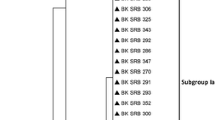Abstract
Urine samples from 211 community children (3–7 years age), from 33 HIV type-1 infected children and from 56 HIV- negative children were collected and analyzed for the presence of BK virus (BKV) DNA by PCR. PCR amplifications were carried out using primers specific for the BKV structural region VP1. We also investigated the distribution of BKV subtypes by a restriction fragment polymorphism assay (RFLP). We demonstrated BKV DNA in 3.8% of 211 community children with a higher prevalence of subtype I. In HIV-1 positive children we detected BKV DNA in 2 urine samples (6%) out of 33, both belonging to subtype I. The HIV-negative cluster did not show any positivity to BKV DNA. The results confirm a more frequent primary BKV infection in children of 3–5 years of age and a higher prevalence in hospitalized children affected by HIV-1. The most relevant finding was that among both the community and HIV-1 positive children the subtype I was the most frequently detected.
Similar content being viewed by others
References
Gardner SD, Field AM, Coleman DV, Hulme B. New human papovavirus (BK) isolated from urine after renal transplantation. Lancet 1971 (i): 1253–1257.
Brown P, Tsai T, Gajdusek C. Seroepidemiology of human papovaviruses. Discovery of virgin populations and some unusual patterns of antibody prevalence among remote peoples of the world. Am J Epidemiol 1975; 102: 331–340.
Flaegstad T, Traavik T, Kristiansen BE. Age-dependent prevalence of BK virus IgG and IgM antibodies measured by enzyme-linked immunosorbent assays. (ELISA) J Hyg 1986; 96: 523–528.
Sundsfjord A, Flaegstad T, Flo R, Spein AR, Pedersen M, Permin H, Julsrud J, Traavik T. BK and JC viruses in human immunodeficiency virus type I-infected persons: Prevalence, excretion, viremia and viral regulatory regions. J Infect Dis 1994; 169: 485–490.
Goudsmit J, Wertheim-van Dillen P, van Strien A, vander Noordaa J. The role of BK virus in acute respiratory tract disease and the presence of BKV DNA in tonsils. J Med Virol 1982; 10: 91–99.
Arthur RR, Shah KV. Occurrence and significance of papovaviruses BK and JC in urine. Prog Med Virol 1989; 36: 42–61.
Dorries K, ter Meulen V. Progressive multifocal leucoencephalophaty: Detection of papovavirus JC in kidney tissue. J Med Virol 1983; 11: 307–317.
Markowitz RB, Thompson HC, Mueller JF, Cohen JA, Dynan WS. Incidence of BK virus and JC virus viruria in human immunodeficiency virus-infected and-uninfected subjects. J Infect Dis 1993; 167: 13–20.
Vallbracht A, Lohler J, Gossmann J, Gluck T, Petersen D, Gerth HJ, Gencic M, Dorries K. Disseminated BK type polyomavirus infection in an AIDS patient associated with central nervous system disease. Am J Pathol 1993; 143: 29–39.
Arthur RR, Shah KV, Charache P, Saral R. BK and JC virus infections in recipients of bone marrow transplants. J Infect Dis 1988; 158: 563–569.
Dorries K, Loeber G, Meixensberger J. Association of polyomaviruses JC, SV40 and BK with human brain tumors. Virology 1987; 160: 268–270.
Elsner C, Dorries K. Evidence of human polyomavirus BK and JC infection in normal brain tissue. Virology 1992; 1991: 72–80.
Jin L. Rapid genomic typing of BK virus directly from clinical specimens. Mol Cell Probes 1993; 7: 331–334.
Jin L, Pietropaolo V, Booth JC, Ward KH, Brown DWG. Prevalence and subtypes distribution of BK virus in healthy people and immunocompromised patients detected by PCR-Restriction Enzyme Analysis. Clin Diagn Virol 1995; 3: 285–295.
Centers for Disease Control. Guidelines for the performance of CD4+ cells determinations in patients with human immunodeficiency virus infection. MMWR 1992; 41: 1–17.
Jin L, Gibson PE, Booth JC, Clewley JP. Genomic typing of BK virus in clinical specimens by direct sequencing of polimerase chain reaction products. J Med Virol 1993; 41: 11–17.
Kwok S, Higuchi R. Avoiding false positive with PCR. Nature 1989; 339: 237–238.
Sambrook J, Fritsch EF, Maniatis T. Molecular cloning. New York: CSH Laboratory Press, 1989: 153–173.
McCance DJ, Gardner SD. Papovaviruses: Papillomaviruses and polyomaviruses. In: Zuckerman AJ, Banatvala J, Pattison JR (eds), Principles and practice of clinical virology. New York: John Wiley and Sons, 1987: 479–506.
Author information
Authors and Affiliations
Rights and permissions
About this article
Cite this article
Di Taranto, C., Pietropaolo, V., Orsi, G. et al. Detection of BK polyomavirus genotypes in healthy and HIV-positive children. Eur J Epidemiol 13, 653–657 (1997). https://doi.org/10.1023/A:1007371320999
Issue Date:
DOI: https://doi.org/10.1023/A:1007371320999




